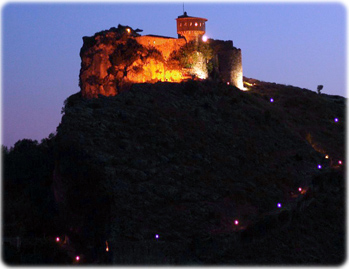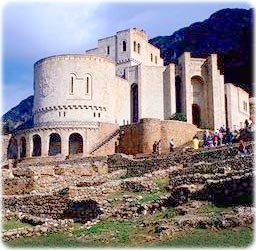
Albania
Albania became independent from the Ottoman Empire, in 1912. Between 1990 and 1992 Albania ended 46 years of Communist rule and established a multiparty democracy. The transition has proven difficult as successive governments have tried to deal with high unemployment, corruption, a dilapidated infrastructure and disruptive political opponents.
In 1998, a new constitution was adopted by popular referendum. Albania is making the difficult transition to a more modern open-market economy. The capital is Tirana.
|
◄ Europe |
Partial view of Tirana, the capital of Albania.

Geography
Administrative divisions - 12 counties (qarqe, singular - qark): Berat, Diber, Durres, Elbasan, Fier, Gjirokaster, Korce, Kukes, Lezhe, Shkoder, Tirane and Vlore.
Terrain: mostly mountains and hills; small plains along coast.
Total area: 28,748 km². Coastline: 362 km.
Highest point: Maja e Korabit (Golem Korab) 2,753 m.
Climate: mild temperate; cool, cloudy, wet winters; hot, clear, dry summers; interior is cooler and wetter.
Ports and harbors: Durres, Sarande, Shengjin, Vlore.
People
Population: 3.1 million (2018).
Religions: Muslim 56.7%, Roman Catholic 10%, Orthodox 6.8%, atheist 2.5%, Bektashi (a Sufi order) 2.1%, other 5.7%, unspecified 16.2% (2011). Note: percentages are estimates; all mosques and churches were closed in 1967 and religious observances prohibited; in November 1990, Albania began allowing private religious practice.
Ethnic groups: Albanian 82.6%, Greek 0.9%, other 1% (including Vlach, Romani, Macedonian, Montenegrin, and Egyptian), unspecified 15.5%.
Language: Albanian 98.8% (official - derived from Tosk dialect), Greek 0.5%, other 0.6% (including Macedonian, Romani, Vlach, Turkish, Italian, and Serbo-Croatian), unspecified 0.1% (2011).
Main source: CIA - The World Factbook.
The Skenderbeg Museum in Kruja, Albania. It honors Gjergj Kastrioti- Skenderbeg (1405-1468), Albanian national hero.
Petrelë Castle, outside Tirana. It was the home of Skanderbeg's sister and part of his defense network against the Ottomans. The central tower dates from around 500 A.D. and the surrounding Byzantine fortifications date from the 11th to the 14th centuries.
|
Copyright © Geographic Guide - Travel European Continent. |


Albania

Brams